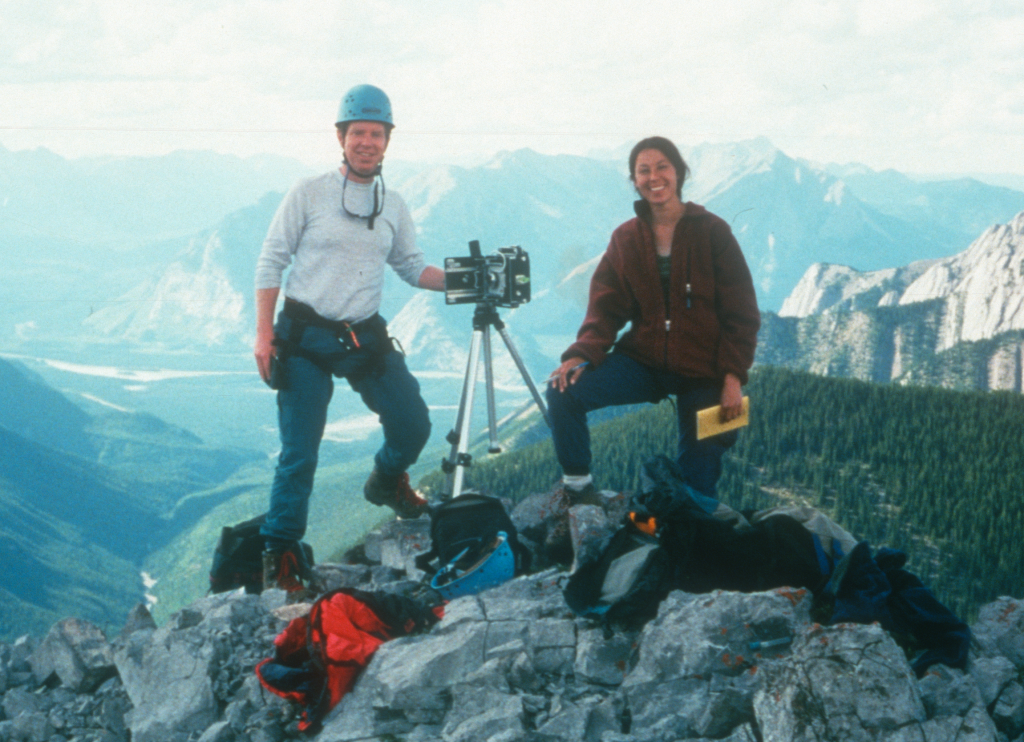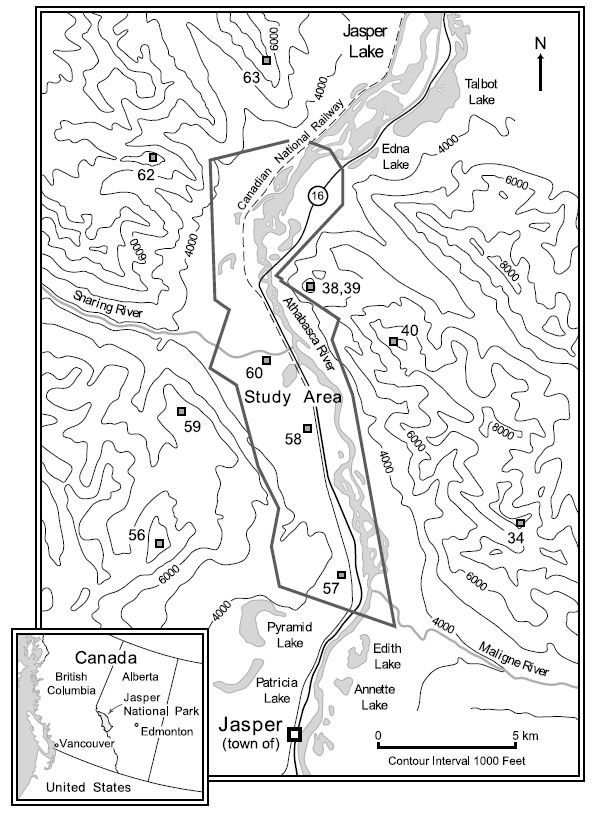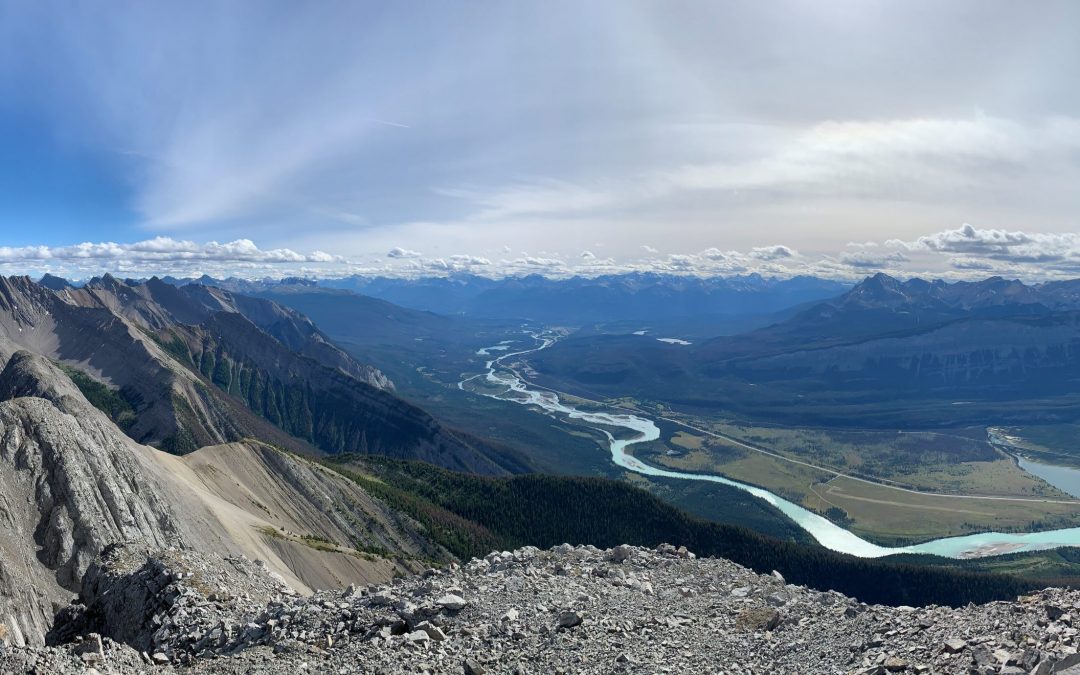by James Tricker, February 15, 2021
After a wonderful week in Kananaskis Country, the field crew arrived in Jasper National Park (JNP) for the final leg of the shortened field season. JNP is where it all began for the Mountain Legacy Project. Back in the summer of 1996, Jeanine Rhemtulla and Eric Higgs began shooting the very first repeat photographs of Bridgland’s 1915 JNP topographical survey. Over the following two summers they would go on to repeat all 735 photographs of the historical JNP survey! Jeanine used innovative quantitative methods to analyze the vegetative changes between these photographic pairs in the Athabasca River valley for her master’s research. Her results indicated an increase in coniferous species and closed-canopy forests on the landscape in JNP, largely as a consequence of shifts in the fire regime over the last century (Rhemtulla et al. 2002).
-

Eric Higgs and Jeanine Rhemtulla at Fiddle II station in Jasper National Park circa 1999. Image: Mountain Legacy Project. -

Jeanine Rhemtulla’s Athabasca River valley study area. Image Rhemtulla et al. 2002
In the lapse of time since Jeanine’s pioneering research, a new disturbance agent has emerged on the landscape in JNP: an infestation of mountain pine beetle. It has killed approximately 200,000 acres of lodgepole pine. My PhD research is centered on a “third view” study—a second repeat of the historical photographs first repeated by Jeanine and Eric—to investigate the implications of this new disturbance on species composition and configuration in the Athabasca River valley. I will employ new methods to quantify the changes occurring in the sets of historical, repeat and third view photographs, assess where ecological novelty (i.e. the ecological and evolutionary effects of global change, Heger et al. 2019) is emerging on a landscape, and inform appropriate management responses.

Our first station in JNP was Mt Greenock on the southern extent of my study area. A calm and clear morning made for a beautiful hike up through an old burn to the panoramic summit. Highlights of the day included the sighting of bighorn sheep, resplendent views up and down the valley, and finding an old straw hat – we made the assumption that it had been accidently left behind by the previous repeat photography team 20 years ago. The next day we were joined by Mike Eder, JNP Cultural Resources Advisor, for a short hike up to Morro Peak to shoot two stations. The first station, located near a cliff edge, was exposed to strong winds and involved waiting for brief lulls to quickly snap the third view photographs. The second station, correctly located after a good hour of searching, was heavily overgrown, and required alternative camera positions to obtain the required sightlines of the original photographs.


Left: Straw hat found at the summit of Mt Greenock. Right: Obscured camera location on Morro Peak. Images: J.Tricker, 2020.
Unsettled weather on the morning of day three afforded the team a rare sleep in, followed by a short afternoon trip down to Snaring River to shoot a station on the southern bank near the confluence with the Athabasca River. It was fascinating to observe the changes in the water course since the historical photographs were taken over 100 years ago. The next day’s objective was the formidable Hawk Mountain – a round trip of 17km with over 1500m of elevation gain. Kristyn and I had an alpine start, leaving the trailhead at 6am, allowing for ample time to navigate the challenging and exposed route with heavy packs. Summiting at noon, the next four hours were spent finding the four camera locations and taking photographs, before carefully retracing our steps back down the mountain. We returned to the trailhead in the dark, where Sonia and Mike awaited us with hot drinks and timbits! The following day was a wash out, allowing for a well-deserved rest day and a small birthday celebration for me.


Left: Summit cairn on Hawk Mountain. Right: MLP volunteer/ninja Kristyn Lang keeping spirits up on the long hike down from Hawk Mountain. Images: J.Tricker, 2020.
For the final four days in the park, we were fortunate to access the majority of the remaining stations via helicopter. An afternoon flight to shoot Mt Esplanade in beautiful weather was followed by very different conditions the following morning when we were dropped off on Roche Bonhomme. Cold and cloudy conditions required us to seek shelter in a nearby cave for a couple hours, before taking the photographs and hiking back down to the trailhead. A change of scenery was in order the next day, as the team was joined by JNP field technician Emily Swerdfager for a drive down to the impressive Athabasca Glacier to a repeat a station in support of a new ecological monitoring project assessing ecotone change (i.e. changes in the transition area between two biological communities) around Wilcox Pass.


Left: Mike Eder, Sonia Voicescu and Kristyn Lang navigating the route down from Roche Bonhomme. Right: Emily Swerdfager and Kristyn Lang repeating Stn 420. Images: J.Tricker, 2020
Our final day in JNP was a long one, involving two important but challenging stations. We had an early morning flight to the summit of the iconic Pyramid Peak, which overlooks the town of Jasper. Although cold and windy, it was a privilege to be up high on a mountain peak so early in the day as the team experienced incredibly clear light afforded by a vivid sunrise. However, it was difficult station to photograph as much of the summit had been leveled since the historical images were taken for the placement of various installations including a microwave facility and a tramway station. We were then ferried over to The Palisade, where our pilot skillfully landed in a small opening surrounded by trees. This station comprised two locations, both overgrown. As with Pyramid Peak, we worked carefully to establish alternative locations that captured the sightlines of the historical images. After snapping our final photograph—over one hundred images taken that the day—we radioed for the helicopter and were soon back at base reflecting on another long but highly productive day.

In summary, 2020 turned out to be an incredibly successful field season given the circumstances. Thanks to careful planning, consistent good weather, and patient teamwork, we were able to achieve close to all of our objectives (see previous blogposts for Crowsnest Pass and Kananaskis Country).

Acknowledgements
We are also indebted to a variety of partners that provide valuable in-kind support and a critical safety network if things were to ever go wrong. I would like to personally thank Mike Eder for championing our work in the park, facilitating our accommodation and helicopter flights, and providing valuable insights on each day’s objectives. I also extend thanks to JNP Resource Conservation Manager Dave Argument, longtime MLP field coordinator Rick Arthur, MLP collaborator Mary Sanseverino, mountain guide Ken Wiley at Mountains for Growth. Finally, we are grateful for the support provided by Lorene Kennedy Graduate Student Field Research Award and the UVic School of Environmental Studies, specifically Research Manager Alina Fisher, who does so much behind the scenes to make our work possible.
Sources
Heger, T., Bernard-Verdier, M., Gessler, A., Greenwood, A. D., Grossart, H.-P., Hilker, M., Keinath, S., Kowarik, I., Kueffer, C., Marquard, E., Müller, J., Niemeier, S., Onandia, G., Petermann, J. S., Rillig, M. C., Rödel, M.-O., Saul, W.-C., Schittko, C., Tockner, K., … Jeschke, J. M. (2019). Towards an Integrative, Eco-Evolutionary Understanding of Ecological Novelty: Studying and Communicating Interlinked Effects of Global Change. BioScience. https://doi.org/10.1093/biosci/biz095
Rhemtulla, J. M., Hall, R. J., Higgs, E. S., & Macdonald, S. E. (2002). Eighty years of change: Vegetation in the montane ecoregion of Jasper National Park, Alberta, Canada. Canadian Journal of Forest Research, 32(11), 2010–2021. https://doi.org/10.1139/x02-112

